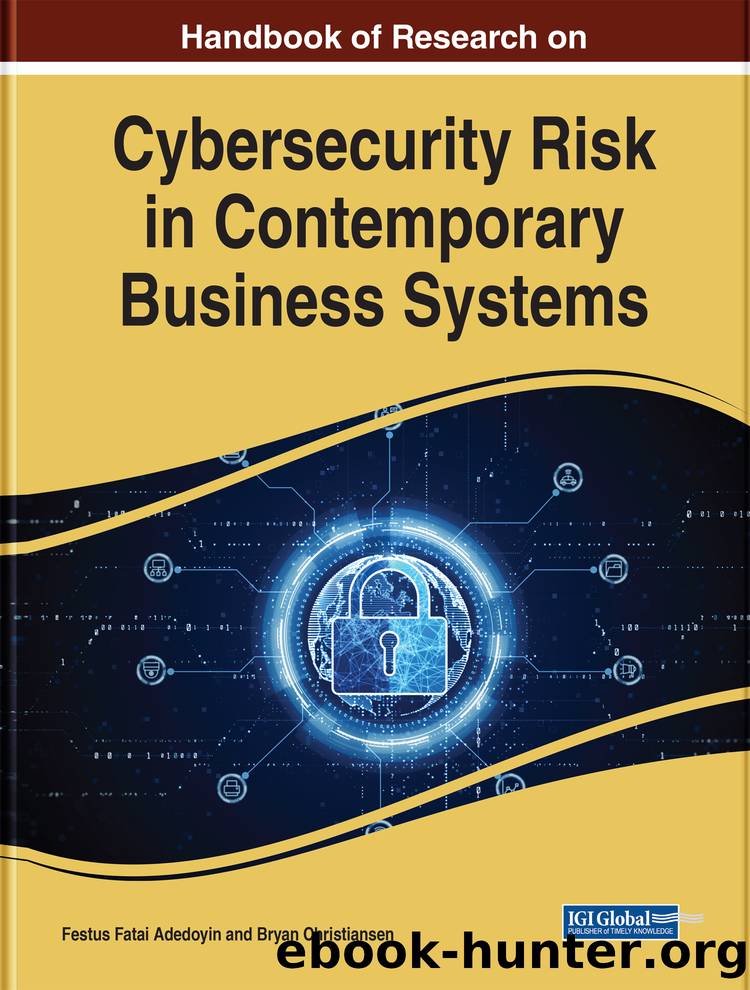Handbook of Research on Cybersecurity Risk in Contemporary Business Systems by Adedoyin Festus

Author:Adedoyin Festus
Language: eng
Format: epub
Publisher: Information Science Reference
Emergency Phase
Policy Initialisation
The first phase of the hybrid security policy is seen as the emergency phase, this phase takes effect upon the occurrence of a crisis event such as the outbreak of a war, pandemic or any other scenario where everyday life is compromised. The emergency phase should be noted as the most complex and difficult stage to navigate, this is due to the rapid change that a business must undergo to begin their process of developing a hybrid security policy.
To further this point, the emergency phase should be considered the main stage where new hybrid approaches would be implemented with most other phases being used for policy improvement and development.
Cyber Awareness
A key part of managing the emergency phase is ensuring that all employees understand the threat landscape that they are exposed to outside of the office, while the goal is to ensure a strong level of security it should be considered that teaching employeesâ relevant cyber awareness is a prevalent factor in keeping the recently exposed end points of a business secure. From carrying out research, the top threats observed in a hybrid workplace consist of fraud/phishing, accidental disclosure of information and ransomware. When gathering data from a group of participants the threat of phishing emails was prevalent as the most frequent cybercrime attempt across various industries including Hospitality, finance, and healthcare. Surveyed data collected also indicated that a lack of Cyber awareness of successful phishing attempts due to employees not understanding the cyber awareness materials they were given. Provided in this stage of the policy plan are some Cyber Awareness materials focused on threats that appear frequently as well as actions employers can carry out to ensure they keep a good level of cyber hygiene while adapting to changes in this emergency phase. These resources have been created in an easy to digest format while also using minimal technical jargon to ensure that employees of all technical experience can understand and benefit from them. These cyber-awareness examples can be built upon as part of the hybrid policy or simply sent out to employees as soon as they are put at risk.
Technological Defences
A significantly difficult aspect of switching into a hybrid working model is ensuring that employees have devices to work on. Data collected has indicated that it can be a struggle to provide the correct equipment for employees when forced into working from home. The essentials that a business should consider for their initial emergency phase is being able to provide every employee with a laptop that they can carry out their day-to-day work on. The choice to provide employees with separate devices from the ones they usually use at home will lower the risk factor of company information accidently being leaked or stolen by using pre-configured devices. Setting up pre-configured devices will allow respective IT departments in companies to control what applications employees install onto their work devices when they are at home, this in turn will drastically lower the risk of an employee unknowingly installing ransomware/Malware on a device connected to work resources.
Download
This site does not store any files on its server. We only index and link to content provided by other sites. Please contact the content providers to delete copyright contents if any and email us, we'll remove relevant links or contents immediately.
Serverless ETL and Analytics with AWS Glue by Vishal Pathak Subramanya Vajiraya Noritaka Sekiyama Tomohiro Tanaka Albert Quiroga Ishan Gaur(2649)
Practical Guide to Azure Cognitive Services by Chris Seferlis & Christopher Nellis & Andy Roberts(2061)
Unity Artificial Intelligence Programming - Fifth Edition by Dr. Davide Aversa(1766)
Open Source Projects - Beyond Code by John Mertic(1704)
The AI Product Manager's Handbook by Irene Bratsis(1698)
Graph Data Modeling in Python by Gary Hutson and Matt Jackson(1668)
Cloud Auditing Best Practices by Shinesa Cambric & Michael Ratemo(1300)
Aligning Security Operations with the MITRE ATT&CK Framework by Rebecca Blair(1290)
Graph Data Processing with Cypher by Ravindranatha Anthapu(1096)
Data Literacy in Practice by Angelika Klidas Kevin Hanegan(1089)
Applied Machine Learning and High-Performance Computing on AWS by Mani Khanuja | Farooq Sabir | Shreyas Subramanian | Trenton Potgieter(1085)
Implementing Multifactor Authentication: Protect your applications from cyberattacks with the help of MFA by Marco Fanti(933)
Fuzzing Against the Machine: Automate vulnerability research with emulated IoT devices on QEMU by Antonio Nappa Eduardo Blazquez(930)
The AI Product Manager's Handbook: Develop a product that takes advantage of machine learning to solve AI problems by Irene Bratsis(815)
The SQL Workshop by Frank Solomon(808)
Data Literacy in Practice - A complete guide to data literacy and making smarter decisions with data through intelligent actions (2022) by Packt(808)
Graph Data Processing with Cypher by Anthapu Ravindranatha;(753)
Serverless Machine Learning with Amazon Redshift ML: Create, train, and deploy machine learning models using familiar SQL commands by Debu Panda Phil Bates Bhanu Pittampally Sumeet Joshi(704)
Network Automation with Go by Nicolas Leiva & Michael Kashin(592)
